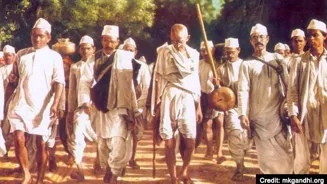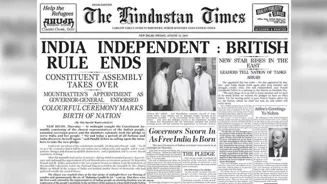Gandhi’s barefoot defiance turned a kitchen staple into a symbol of revolution
Imagine an old man in homespun cloth, walking barefoot through the dust-filled
roads of Gujarat. Behind him, thousands follow. Their destination? Not a battlefield, but the sea. Their weapon? Salt.
On March 12, 1930, Mohandas Karamchand Gandhi left his Sabarmati Ashram with 78 volunteers on a 240-mile march to the village of Dandi. Their mission was simple yet radical: to produce salt—an act that would become one of the most iconic acts of civil disobedience in history.
Salt and sovereignty
For centuries, Indians harvested salt from their own land. However, under British rule, the Salt Act of 1882 rendered it illegal for them to produce or sell it. The British maintained a monopoly and imposed heavy taxes. Even the poorest Indian, sweating under the colonial sun, had to pay the Crown for the salt they relied on for survival.
Gandhi recognised this injustice for what it was—a silent cruelty that unified every Indian, regardless of wealth or faith. Salt was not merely a seasoning; it symbolised sovereignty.

(Credit: Knocksense )
The long walk to freedom
Gandhi's decision to protest the Salt Tax was as brilliant as it was bold. It was non-violent, symbolic, and impossible to ignore. As he marched from village to village, his message rang clear: break the unjust law, but do it peacefully.
By the time he reached the shores of Dandi on April 5, the crowd had swollen to tens of thousands. On the morning of April 6, Gandhi bent down, scooped up a fistful of salty mud, and held it aloft. With that humble gesture, he had defied the British Empire.

(Credit: Britanica )
A nation follows suit
That pinch of salt ignited a storm. Throughout the country, Indians started making salt unlawfully. In coastal cities like Mumbai and Karachi, protesters boiled seawater in clay pots to harvest crystals of defiance.
On May 21, poet and activist Sarojini Naidu led 2,500 volunteers to raid the Dharasana Salt Works. British-led Indian police struck them down with iron-tipped lathis. The protesters didn't raise a hand in return. American journalist Webb Miller was present, and his reports sent shockwaves across the world.
The crackdown and its cost
The British responded with brute force. Over 60,000 people were arrested, including Gandhi, on May 5. Yet, the movement persisted. Farmers, students, women—even children—joined the wave of non-cooperation.
The Salt March transformed the Indian independence movement into a mass uprising, not just a debate among lawyers or an urban elite's demand. It elevated Gandhi onto the world stage and compelled Britain to recognise that its Indian subjects would no longer quietly submit.
Legacy of a grain of salt
In January 1931, Gandhi was released. He met with Viceroy Lord Irwin and agreed to suspend the civil disobedience campaign in exchange for participation in the London Round Table Conference on India's future.
Although the conference was mostly unproductive, it proved one truth: Gandhi could no longer be ignored. A frail man with no office, no army, and no wealth had shaken the foundations of the British Empire—with nothing but moral clarity and a handful of salt.

(Credit: Hello Travel )
A quiet revolution that echoed loudly
The Salt March wasn't just a protest; it was a display of defiance, a lesson in how power can be challenged with patience and purpose. It inspired Indians to believe that liberation was not only achievable—it was certain.
Gandhi's footsteps in the sand left more than footprints. They marked the path to India's independence in 1947. And that handful of salt? It remains, to this day, a timeless symbol of resistance.














